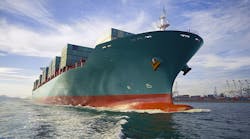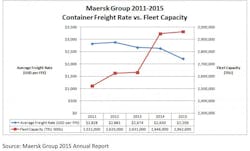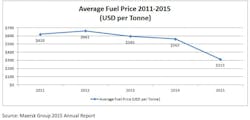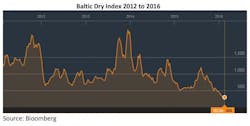I was recently on a conference call with a group of managers from one of the world’s most well respected freight brokers. During the call one manager stated that the ocean freight market was the softest he has seen in approximately nine years. He went on to say that any purchaser of ocean freight who has not recently spoken with their ocean freight service provider is probably paying too much. A cursory review of recent industry data supports both statements.
In their 2015 annual report, the Maersk Group reported that their average 40-foot container freight rate has decreased 22% since 2011, while their fleet capacity during this same time frame has increased by 17%. Adding to this bearish environment, the cost of bunker fuel has decreased 49% from 2011 to 2015.
Maersk is a well-run company, so you can be certain they are not alone in this regard. While lower fuel prices have provided some cost relief to the industry, downward price pressure on ocean container freight has become an industry-wide problem. The China Export Containerized Freight Index is down 20% from 12 months ago on the China to U.S. (West Coast) trade lane. The same index is down 28% and 38%, respectively, on the China to U.S. (East Coast) and China to Europe trade lanes. This dynamic has been caused by excess vessel capacity (i.e., from ships brought online during more optimistic times), the economic deceleration in China and the subsequent ripple effect to other emerging markets.
The pain is not limited to containerized freight. The Baltic Dry Index (BDIY) is an economic indicator issued daily by the Baltic Exchange based in London, England. The index provides an assessment of the price of transporting large bulk dry cargo (e.g., grain, coal, copper) by sea. This index is down 43% over the last 12 months and 77% over the last five years.
Although the ocean shipping industry is in a dire situation, it will not stay this way in perpetuity. The industry is adjusting. Carriers are mitigating excess capacity by scrapping and temporarily decommissioning their existing vessels while simultaneously deferring new vessel deliveries. Therefore, if ocean freight customers want to leverage current industry economics to achieve cost savings, now is the time to act before these structural changes take hold and rates start to recover.
Companies which directly purchase and control the cost of their ocean freight should compile 1-3 months of ocean freight bills and issue an informal Request for Quote (RFQ) from several ocean freight carriers who compete with their incumbent. If an organization purchases their freight through a broker or 3PL, then it should initiate discussions to verify that ocean freight savings are being passed through in a timely manner. If they are not, then the above-mentioned RFQ approach can be applied to competing 3PL organizations to conduct a comparative rate analysis.
Organizations that do not control the cost of their ocean freight because, for example, they purchase inventory under Delivered Duty Paid (DDP) Inco-terms, can still achieve ocean freight cost savings. If your suppliers have not proactively spoken to you about passing through any ocean freight savings then you need to initiate the discussion.
One way to quantify the potential value proposition is to ask your supplier to provide fully-burdened pricing for an identical purchase order (e.g., requiring a 40-foot container) using two methods:
Method #1: The order is delivered via DDP Inco-terms in which the seller controls the cost of freight.
Method #2: The order is delivered via Ex Works (EXW) Inco-terms in which you, the buyer, control the cost of freight.
The price estimate for the EXW order will be demonstrably lower and that “Inco-term differential” is effectively what you are paying to transport your freight under the DDP Inco-terms.
Your next step is to engage a reputable steamship line (e.g., Maersk) or NVOCC (non-vessel operating common carrier) and ask them to provide you with fully burdened, door-to-door pricing for a 40-foot container, based on the volume currently being handled by your supplier. If the quoted door-to-door container rate is demonstrably less than the above mentioned Inco-term differential, you should consider converting your Inco-terms to capture the savings opportunity.
As you commence discussions with your incumbent or prospective service provider, keep the following objectives in mind:
• Ocean freight pricing for specific trade lanes should be a fixed contract rate for a predetermined level of container volume. The caveat with this strategy is that there may be a carrier penalty for containers not tendered. Even in a down market, a carrier may take the position that if they are providing a bargain rate for a committed number of weekly, monthly, or annual containers, they should have coverage if those volume commitments are not fulfilled.
• Work towards a mutually beneficial agreement with your existing or prospective ocean carrier. Take caution in seeking the lowest possible rate. You want your service provider to move your freight profitably. If they are losing money on your freight today, your containers will be left on the dock when the market recovers.
• If a fixed pricing contract cannot be achieved, be certain that you fully understand the pricing methodology for the spot market. For example, ask your carrier or forwarder if container pricing is pegged against a predetermined index (e.g., World Container Index, Drewry, or the Baltic Dry Index). Determine if bunker fuel is fixed or pegged to current price of Brent Crude oil.
When rates do eventually recover, remember it is not mandatory to accept a carrier’s General Rate Increases (GRI). If you have a long-term contract, any GRI should be compliant to the language and/or provisions in the original agreement. If you don’t control your freight, waiting to decline future GRI is a passive strategy that leaves money on the table. Now is the time to take action. Ocean freight is a buyer’s market.
Brewster Smith is project manager with Tompkins International, a supply chain consulting and implementation firm that maximizes supply chain performance and value creation.






